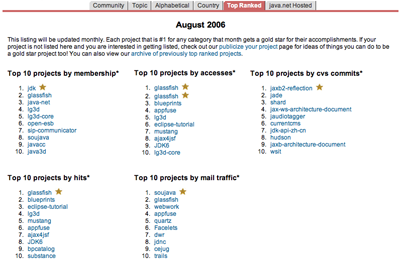At some point, I plan on replacing the JSF+JSP combination in AppFuse with JSF+Facelets. However, I'm wondering if this is just an interim step to a more full-featured framework like Shale and its Clay templates.
Has anyone out there tried both Shale and MyFaces+Facelets? If so, which one worked best for you?
Should we use Shale for the JSF framework in AppFuse or is MyFaces + Facelets good enough?
Can JSP-based components (particularly Ajax ones) be used with Clay and/or Facelets? What's the best Ajax-enabled component library available for JSF? I know there's more everyday, so I'm looking for first-hand, real-world experience here. Thanks in advance for any advice or stories you'd like to share!
Karsten Voges has written a nice critique of AppFuse titled Five things I hate about AppFuse. I started a new JSF+Hibernate project with AppFuse yesterday, so I definitely feel some of his pain. Let's examine his points one-by-one:
1. It's nice to choose between the usage of JSP 2.0 or before, but making the changes (to all jsps and the web.xml) every time I build my app sucks.
I absolutely agree. I spent a good hour modifying build.xml, web.xml, etc. to switch my app from JSP 1.2 to JSP 2.0 yesterday. You can modify your build.xml to permanently switch to JSP 2.0, but it doesn't get everything. I'll create a separate script for 1.9.3 and the upcoming 1.9.4 to make this cleaner.
2. Seperating the classes in web, services and dao is good, but I hate the building of jar-Files for the different layers. Just take the classes under dao and service and copy them into the war or move them over to the webapps folder as it is done with the web classes!
Yeah, I've proposed doing this a couple of times on the user mailing list. It always gets shot down by existing users. I'm sure it'd be possible to write a script to do this, but it'd be no fun to write.
3. Eclipse crashed with OutOfMemory errors. Always when trying to open the build file. The build file is really, really long, with lots of stuff in there. IMO 50% of it could be deleted.
Hmmm, I rarely have OOM errors with Eclipse, but I also used Bruce's tip for increasing Eclipse's available memory. If you're using Windows, here's how to bump up Eclipse's memory.
4. Generation of Hibernate-Mapping files. I really hate it to look within a jarfile how the Hibernate mapping file looks like. It is nice to get it generated, but I prefer to be able make adjustments to it by hand to try out things quickly. And it is quite hard to enter special SQL statements in an Hibernate file, if it gets overwritten all the time.
You can create/modify the Hibernate mapping files by hand if you prefer. From the FAQ:
If you have an @hibernate.class tag on a POJO - hibernatedoclet will generate the mapping file into build/dao/gen. If you have a mapping file (*.hbm.xml) file for your POJO in the src/dao/**/model/*
directory, it will overwrite the generated version. If you don't want to worry about the two conflicting - just remove the @ sign from @hibernate.class in your POJO and put your hbm.xml file in the model
directory.
No build.xml modification are need for this to work. The "package-dao" target will include these mapping files. If you want to get rid of the hibernatedoclet process, you can do that- but make sure and run it first - and then copy all of the generated hbm.xml files into your model directory.
5. I don't like to get my struts.xml merged from many sources. I like to have one struts-config file holding all my struts configuration.
I agree this is kinda painful, but so is developing with Struts.  You should be able to move the generated struts-config.xml into web/WEB-INF and remove the <strutsconfigxml> from build.xml to get the behavior you're looking for.
You should be able to move the generated struts-config.xml into web/WEB-INF and remove the <strutsconfigxml> from build.xml to get the behavior you're looking for.
As far as throwing out the build.xml, I'm actually planning on doing that with my current project. I will keep it in place for the development phase, but I hope to move the application into a large build system once I'm done. Since it's all Java code and XML in the end, this shouldn't be hard to do. I did it when migrating to Maven 2, so I know it's possible. As far as Karsten's opinion of Maven 2, he may be right - but I hope to make a strong effort to make it very useable when using AppFuse. In fact, I hope to make it possible for users to use their IDE their entire time, with no need to run any Maven commands. Of course, that could be a pipe dream - only time will tell.
As far as sounding like the BileBlog, the more you rag on AppFuse, the better. Remember, screaming users are a good thing.


 You should be able to move the generated struts-config.xml into web/WEB-INF and remove the <strutsconfigxml> from build.xml to get the behavior you're looking for.
You should be able to move the generated struts-config.xml into web/WEB-INF and remove the <strutsconfigxml> from build.xml to get the behavior you're looking for.

